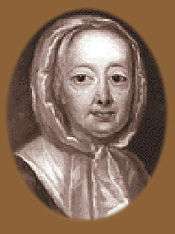Hannah Callowhill Penn

Hannah Callowhill Penn (11 February 1671 – 20 December 1726) was the second wife of Pennsylvania founder William Penn; she effectively administered the Province of Pennsylvania for six years after her husband suffered a series of strokes and then for another eight years after her husband's death. She served as acting proprietor from 1712 until her death in 1726.
Hannah Callowhill was born in Bristol, England, the daughter of Thomas Callowhill, a merchant there. A Quaker, she married William Penn March 5, 1696, when she was 25 and he was 52. She was pregnant with their first of eight children when the couple embarked from England for their three-month voyage to America in 1699. She lived in great style, both in Philadelphia and at Pennsbury Manor, a beautiful estate located in Bucks County, on the Delaware River. When William Penn died at age 73 on July 30, 1718, his will gave Hannah Penn full control of the colony and his fortune. William Penn's oldest son by his first marriage, William Penn, Jr., sought to dismiss his father's will in order to obtain control of the colony. His suit was unsuccessful, and Hannah Penn remained in charge of the colony until she died from a stroke in her son's house in London at age 55.[1] Her deputy in Pennsylvania from 1718 till 1727 was Sir William Keith.
Children
Penn Family
- John Penn ("the American") (1699–1746), never married.
- Thomas Penn (1702–1775), married Lady Juliana Fermore, fourth daughter of Thomas, first Earl of Pomfret.
- Margaret Penn (b. 1704)
- Richard Penn, Sr. (1706–1771)
- Dennis Penn (b. 1707, d. before 1727)
- Hannah Margarita Penn (b. 1708, died Mar 1708)
Legacy
Hannah Penn is one of the few individuals and the first woman granted the status of Honorary Citizen of the United States, awarded her by Presidential Proclamation by an Act of Congress (PL. 98-516) by Ronald Reagan on November 28, 1984.
When William Penn was laying out the city of Philadelphia in the early 1680s, he named Callowhill Street in his wife's honor. Similarly, a street in Perkasie, Pennsylvania, is also named in her honor.
A middle school in York, Pennsylvania, is named in her honor.
Pennsylvania Governor, Tom Corbett, named March 12, 2013 "Hannah Callowhill Penn Day."
Governor Corbett and Mrs. Susan Corbett commissioned a posthumous portrait of Hannah Penn by Pennsylvania portrait artist Ellen Cooper. The portrait was unveiled at a ceremony at the Pennsylvania capitol during Women's History Month, March 19, 2014.[2][3] After being publicly displayed in the governor's reception room for several months, on January 15, 2015, the portrait was hung in the Pennsylvania governor's office among portraits of other early leaders of Pennsylvania.[4] However, as of March 2015 the portrait is in storage; Governor Tom Wolf asked for it to be moved into the Governor's Reception room, but he said because of safety concerns it was returned to the Historical and Museum Commission.[5] According to Penn Live, "It is likely that it will be sent, for a time, to Pennsbury Manor, the estate from which the Penns first governed the new colony. Then, it is headed to the state museum for an exhibit on Iconic Stories of Pennsylvania."[5]
On March 19, 2014, the Pennsylvania Commission for Women awarded the first Hannah Penn Leadership Awards to honor Pennsylvania women who have been outstanding mentors and role models through their leadership, service and commitment to empowering women and girls in the commonwealth.[6]
External links
- Presidential Proclamation 5284
- Sketch of Hannah Penn
- Pennsylvania Historical Marker and portrait
- Hannah Callowhill Penn at Find a Grave
References
- ↑ Barbara Wells Sarudy. "William Penn's 2nd Wife, Quaker Hannah Callowhill Penn 1671–1726". 17C American Women. Retrieved 17 April 2015.
A week later she died at the home of her son John in London, following another stroke.
- ↑ "Corbetts unveil Capitol portrait of Hannah Penn". WHTM-TV. 19 March 2014. Archived from the original on 2014-10-10. Retrieved 7 October 2014.
- ↑ "News Details". Pa.gov. Retrieved 2015-04-17.
- ↑ "Portrait of Hannah Callowhill Penn Hung in the Governor's Office". Pa.gov. 2015-01-15. Archived from the original on 2015-04-02. Retrieved 2015-04-17.
- 1 2 Roddy, Dennis (2015-03-27). "It took centuries to recognize Pa's first woman governor, Hannah Penn, now Gov. Wolf has buried her again". PennLive.com. Retrieved 2015-04-17.
- ↑ http://www.portal.state.pa.us/portal/server.pt/community/commission_for_women/20750